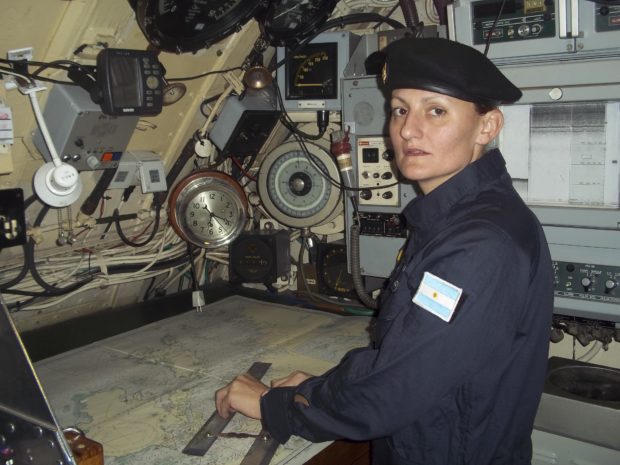
On this undated photo released by the Argentine Navy, Eliana Krawczyk poses for a picture inside an Argentine submarine. Krawczyk, the first female submarine officer in Argentina, is one of 44 missing crew members of the ARA San Juan that went missing last November 15, 2017. (Argentine Navy via AP)
MAR DEL PLATA, Argentina — Experts are analyzing sounds that might have come from a missing Argentine submarine, the country’s navy said on Monday, reviving hope among relatives of the 44 crew members aboard.
Spokesman Enrique Balbi told reporters that a United States Navy P-8 Poseidon aircraft was dispatched to check an area where the noise was heard by two Argentine navy ships to help in the effort to isolate the source of the sounds.
The “noise” was heard in the South Atlantic about 360 kilometers (220 miles) from the Argentine coast and at a depth of about 650 feet (200 meters), Balbi said.
A US Navy official familiar with the search cautioned that it was unclear whether the Argentines described the sound as something similar to tools being banged against the hull of a submarine as was previously reported. The source spoke on condition of anonymity because the information about the sounds comes from the Argentine government.
The submarine – ARA San Juan – went missing last Wednesday as it sailed from the extreme southern port of Ushuaia to the coastal city of Mar del Plata. More than a dozen international vessels and aircraft have joined the search, which has been hindered by stormy weather that has caused waves up to 20 feet (6 meters).
In the first confirmation of a malfunction, an Argentine navy official said earlier Monday that the submarine reported a battery failure on Wednesday and was returning to base when it went missing.
Brief satellite calls over the weekend had originally been thought to indicate the crew was trying to re-establish contact, prompting emotional celebrations by family members and officials. But Balbi said earlier Monday that officials analyzed the seven low-frequency satellite signals and determined they were not received from the submarine.
Although the German-built diesel-electric vessel carried enough food, oxygen and fuel for the crew to survive about 90 days on the sea’s surface, the sub had only have enough oxygen to last seven days submerged, Balbi said.
At the Vatican, Pope Francis, a native of Argentina, said he was sending “fervent prayers” for the crew.
The US Navy ordered its Undersea Rescue Command based in San Diego, California, to deploy to Argentina to support the search for the submarine. The command includes a remotely operated vehicle and vessels capable of rescuing people from bottomed submarines.
Pledges of help also came from Chile, Uruguay, Peru, Brazil, and Britain, the latter sending a polar exploration vessel – HMS Protector.
“This is encouraging,” Maria Rosa Balenstro, the mother of submarine officer Fernando Vicente Villareal, told The Associated Press after she heard about the underwater sounds. “We want to thank all of the countries that are helping so that the crew can be found.”
Other relatives of the crew members took to social media Monday to ask for support during the search.
“Pray so that my husband, Fernando Santilli can return home,” Jesica Gopar wrote. “He’s in the San Juan submarine.”
The submarine was originally scheduled to arrive on Monday at the navy’s base in Mar del Plata, which is about 400 kilometers (250 miles) southeast of Buenos Aires.
Argentine President Mauricio Macri met with family members at the base as they waited anxiously for news about their loved ones.
“We can make up a thousand movies with happy and sad endings, but the reality is that the days pass by and not knowing anything kills you,” Carlos Mendoza, the brother of submarine officer Fernando Ariel Mendoza, told the AP.
“Every minute is oxygen that’s worth gold,” Mendoza said. /kga